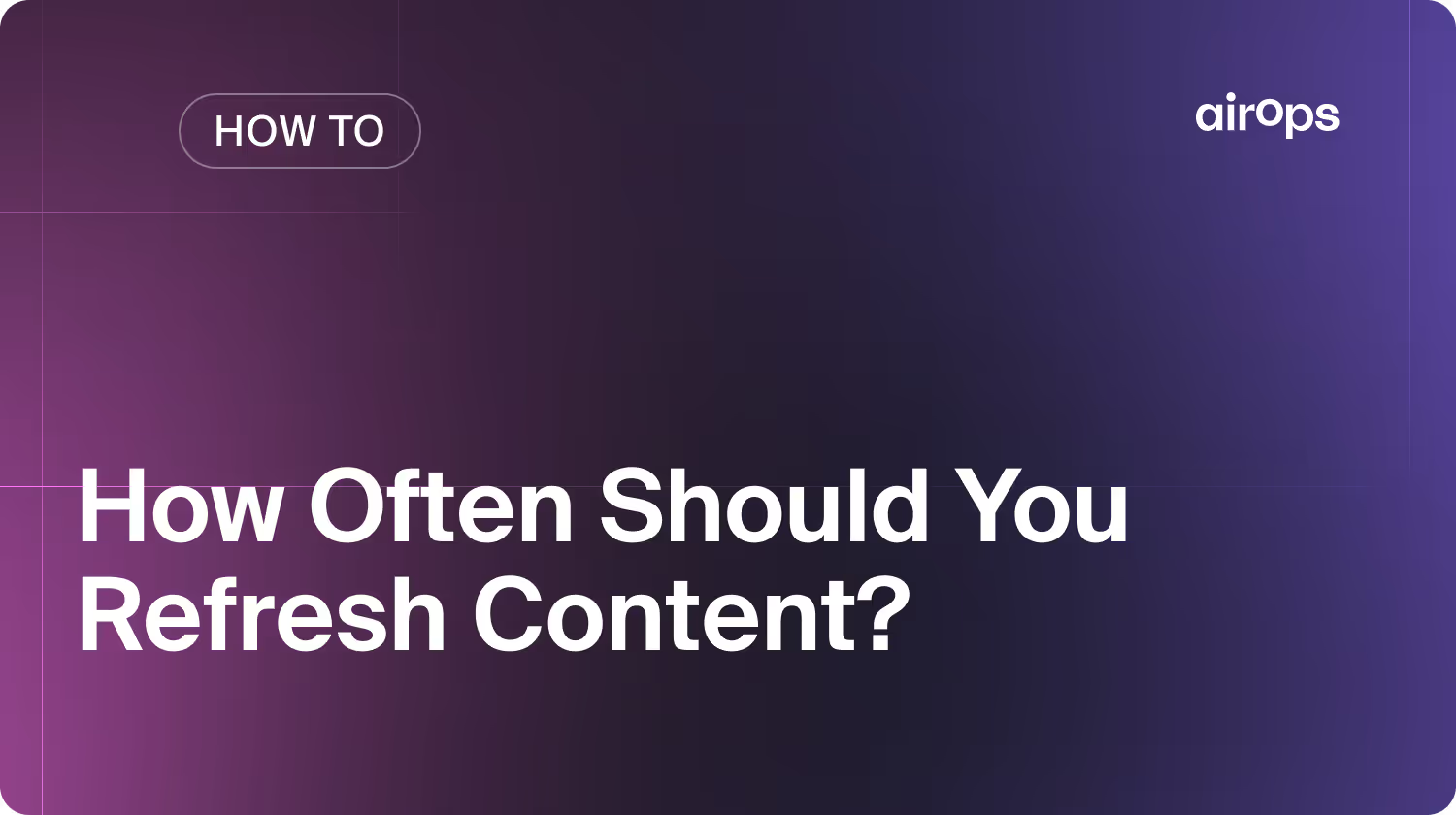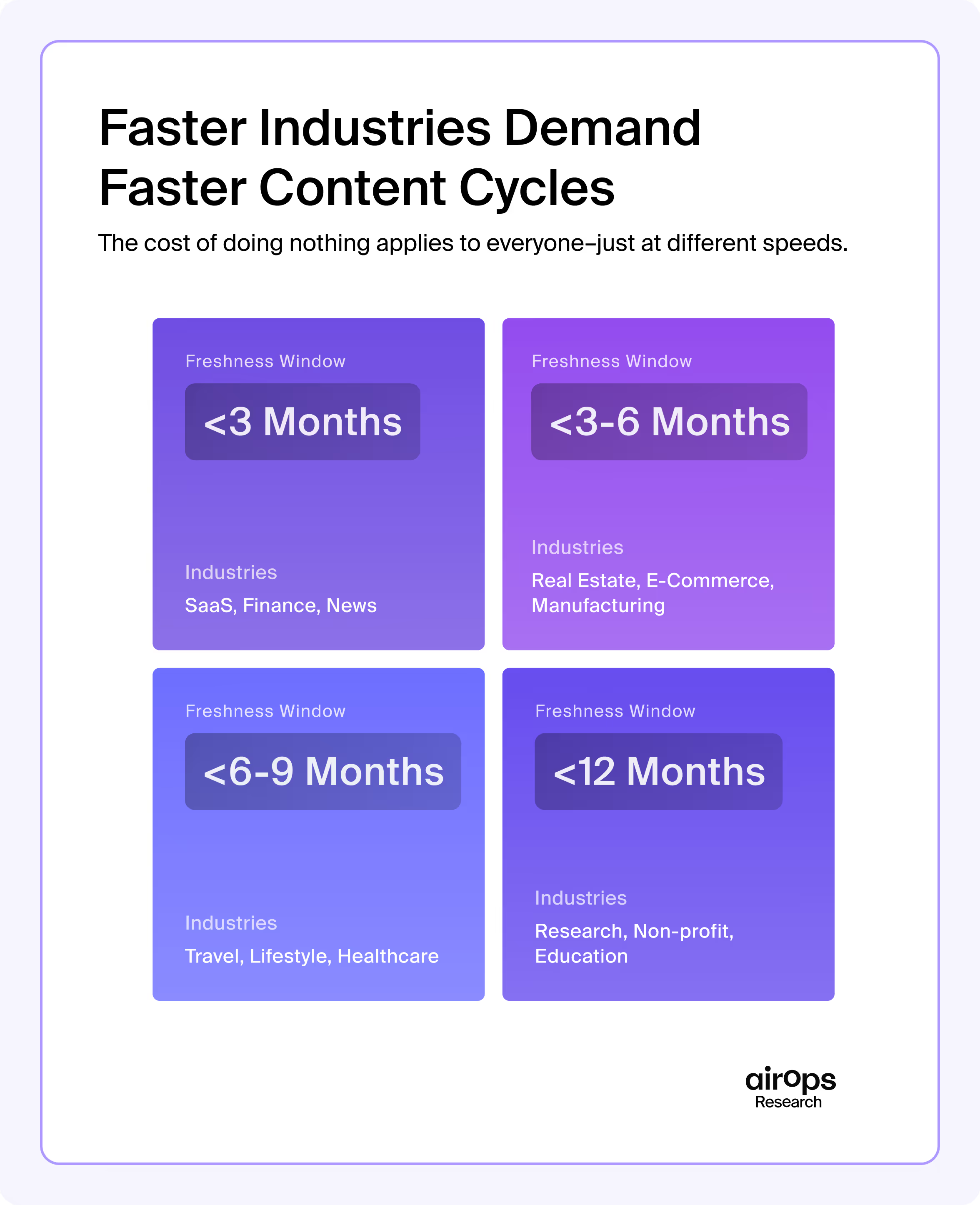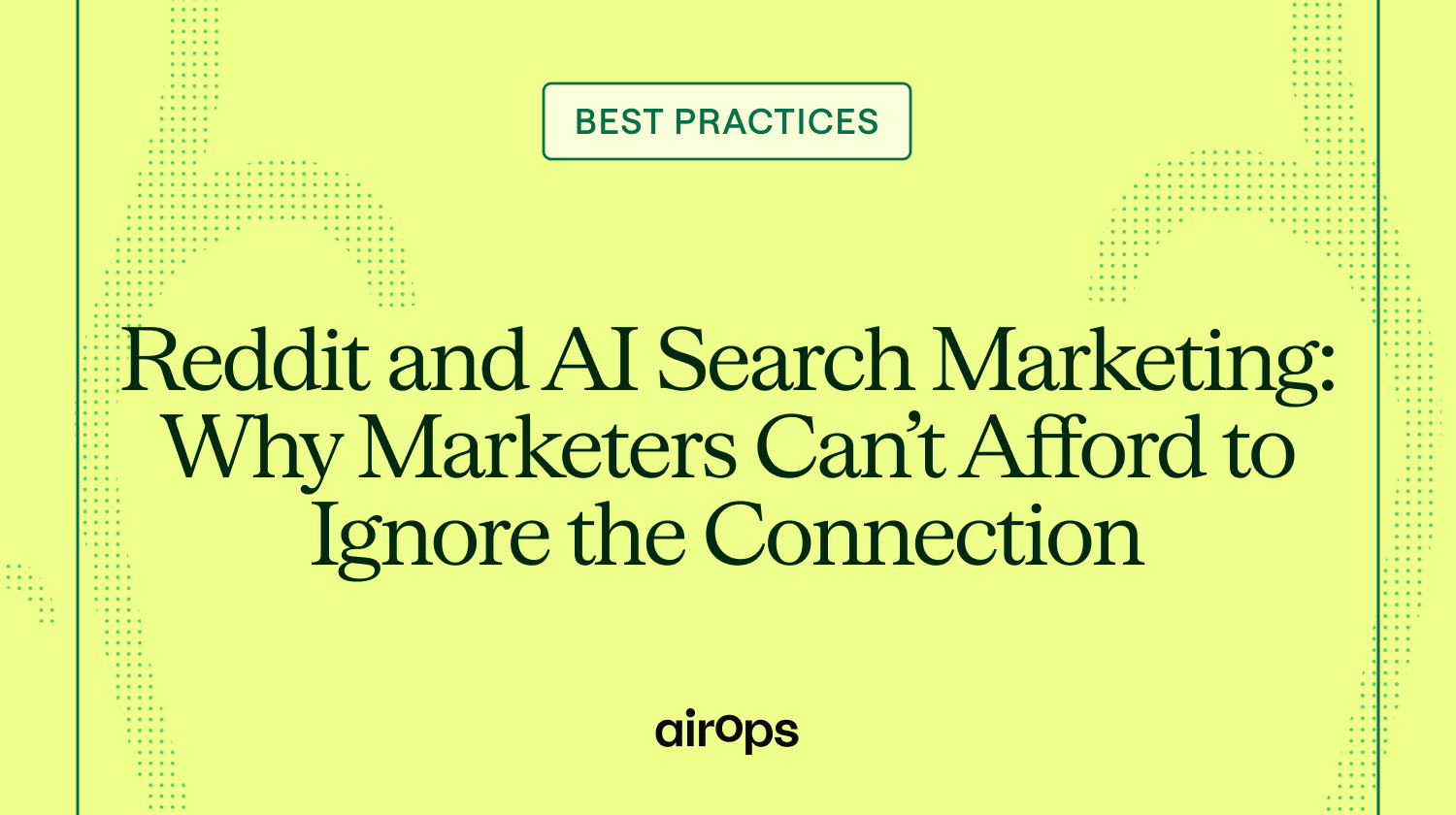How Often Should You Refresh Content?

Content decay is the silent killer of your search rankings and organic traffic. Your best-performing pages lose visibility as competitors update their content, search intent shifts, and AI engines favor fresher sources. Without a systematic content refresh strategy, you risk losing years of content investment to preventable decay.
The challenge isn't just knowing what to refresh—it's understanding when and how often to update content.
You need data-driven frameworks that identify declining pages, prioritize high-impact refreshes, and optimize for both traditional and AI-powered search. This guide delivers proven strategies for content refresh cadence, performance monitoring, and scalable optimization workflows.
You'll learn how to detect traffic losses, establish refresh schedules, optimize for AI visibility, and measure impact. These frameworks help you transform content refresh from reactive maintenance into a proactive growth engine.
How Often Should You Refresh Content to Stay Competitive?
Content refresh frequency depends on your industry's pace, the competition, and content type. High-competition topics and rapidly changing industries require monthly or quarterly updates for top-performing pages. Evergreen content in stable niches can maintain rankings with annual comprehensive refreshes.
Optimal refresh schedules:
• High-value pages: Update your top 20% traffic drivers every 3-6 months to protect revenue-generating content from competitive threats.
• Industry news content: Refresh time-sensitive topics monthly or quarterly to maintain relevance and capture trending search queries effectively.
• Evergreen resources: Conduct annual deep refreshes on guides and tutorials, with minor updates when significant industry changes occur.
According to Google Search Central, Google’s “query deserves freshness” systems are designed to show fresher content for queries where recency is expected. In practice, that means time-sensitive topics warrant more frequent updates, while evergreen assets can follow a longer, research-backed cadence without sacrificing visibility.
Create a content refresh calendar that prioritizes pages by business impact and decay risk. This systematic approach prevents reactive scrambling when rankings suddenly drop across multiple pages.

What Is the Best Update Frequency for AI Visibility? Every 30-60 Days
AI visibility requires more frequent content updates than traditional SEO because answer engines prioritize fresh information. Updating key content every 30–45 days is the current sweet spot for maintaining high visibility in AI-generated answers.
Why 30–60 Days? The Evidence
1. AI Models Apply Aggressive Freshness Weighting
Recent data from our internal research at AirOps shows that freshness is no longer a “nice-to-have” — it’s a core prerequisite for being visible in AI answer engines.
- In a 2025 study, we found that 95% of pages cited by generative-AI systems were updated within the last 10 months, and pages showing a visible “last updated” timestamp earned 1.8× more citations than those without.
- Pages that hadn’t been updated in more than a year were more than 2× less likely to be cited or surface at scale in AI-driven search streams.
- If you map this to practical timing: being updated within ~30 days puts you in the “very fresh” zone; ~30-45 days still signals strong recency; once you cross ~60 days you’re entering a much weaker freshness tier for AI citation relevance.
2. Rapid Topic Drift in AI Answers
Unlike static search engines, answer engines (e.g., ChatGPT, Perplexity, Bing Copilot) are constantly remixing sources, context, and citations for each query.
- Our study shows that from one sampling of answer-engine citations to the next, only ~30 % of brands remain visible across queries. That means the “pool” of eligible sources shifts quickly.
- Because you’re competing not just on keywords but on being top-of-mind within the model’s retrieval window, updating every ~30–45 days allows you to stay in that rotation rhythm rather than falling out simply because your content hasn’t moved recently.
3. Higher Citation Probability
Freshness is the threshold for being considered at all for citations in many answer engines.
In practical terms: if your page is updated within ~30–60 days, you’re more likely to appear in the short-list of sources that generative systems pick when compiling responses. If you wait longer, you risk being excluded from consideration entirely.
4. Competitive Intelligence: Staying Ahead Matters
In fast-moving industries (SaaS, finance, tech) the bar for “recent” keeps moving. Your competitors are refreshing more often, updating stats, referencing new research, and shifting examples.
- If they update every 30–45 days and you update every 90+, you’re visibly older even if your content is better. Our data shows that content decay often happens because newer assets out-fresh yours, not because yours is dramatically worse.
- In short: updating every 30–45 days gives you a freshness edge that helps defend and grow visibility in answer-engine contexts.
What This Means for Your Refresh Cadence
Given this evidence, here’s how to calibrate your refresh strategy:
- High-impact/high-intent pages (product pages, key workflows, strategic thought-leadership): update every ~30 days
- AI-era “evergreen” content (AEO Hubs, core guides, cornerstone pieces): update every ~45–60 days
- Research/original-data assets: update every ~90 days
- Low-priority or legacy posts: revisit every ~6 months, with a focus on organic-search value rather than AI visibility.
AI-specific refresh strategies:
• Freshness signals: Add new data, examples, or insights quarterly to demonstrate ongoing authority and expertise to AI crawlers.
• Citation optimization: Update statistics, research references, and expert quotes every 2-3 months to increase citation likelihood in AI answers.
• Structured data updates: Refresh schema markup and FAQ sections regularly to improve content extractability for answer engine algorithms.
Monitor your brand mentions in AI responses weekly to identify when visibility drops. This real-time feedback helps you adjust refresh frequency based on actual AI visibility and update frequency patterns.
How Do I Evaluate Refreshed Content Performance Over Time?
Evaluating refreshed content performance requires tracking specific metrics before and after updates. Monitor organic traffic, keyword rankings, engagement rates, and AI citations across a 90-day period. Compare these metrics against your baseline to measure the true impact of refresh efforts.
Performance tracking essentials:
• Traffic recovery analysis: Track organic sessions month-over-month, comparing refreshed pages to their pre-update baseline and identifying sustained growth patterns.
• Ranking position changes: Monitor keyword movements for target terms, measuring both primary rankings and new long-tail opportunities captured post-refresh.
• AI visibility metrics: Measure citation frequency in ChatGPT, Perplexity, and AI Overviews to understand your content's authority in answer engines.
Document these metrics in a performance dashboard that connects refresh activities to business outcomes. This data proves ROI and informs future refresh priorities across your content portfolio.
According to Content Marketing Institute, top-performing B2B marketers are more likely to measure and demonstrate content performance effectively (53%). This shows the need to define clear KPIs and baselines before each refresh. Align measurement with business goals so you can attribute gains to specific updates and prioritize the next round of optimizations.
How Do I Find Blog Posts That Lost Organic Traffic Over Time?
Finding blog posts with declining traffic starts with systematic performance monitoring using analytics tools. Compare year-over-year and month-over-month traffic data to identify pages experiencing consistent drops. Focus on pages that previously drove significant traffic but show downward trends over multiple periods.
Content decay detection methods:
• Google Analytics 4 analysis: Create custom reports comparing current traffic to previous periods, filtering for pages with 20%+ traffic declines.
• Search Console position tracking: Identify pages where average position dropped by 3+ spots for primary keywords over 60 days.
• Competitive gap analysis: Use tools to find keywords where competitors now outrank you despite your previous dominance.
Set up automated alerts for significant traffic drops to catch decay early. Regular monitoring helps you intervene before pages lose visibility completely in search results.
Smart Refresh Strategies That Scale Your Content Impact
Successful content refresh goes beyond updating publication dates or tweaking meta descriptions. You need systematic approaches that identify high-impact opportunities and execute updates efficiently.
- Prioritize by business value: Focus refresh efforts on pages that directly impact revenue, lead generation, or strategic keyword rankings.
- Batch similar updates: Group content requiring similar refreshes to streamline research, writing, and optimization workflows across multiple pages.
- Automate decay detection: Use monitoring tools that flag performance drops automatically, eliminating manual spreadsheet analysis and missed opportunities.
- Document refresh history: Track what changed, when, and why to build institutional knowledge about effective refresh tactics.
- Test incrementally: Start with small updates on select pages before rolling out major refreshes across entire content portfolios.
Real-world success demonstrates the power of systematic refresh strategies. Descript achieved a 35% increase in organic visits to refreshed blog content and 9x faster content refresh using automated content refresh workflows, freeing up internal resources for strategic growth initiatives. Their approach combined automated decay detection with scalable optimization workflows, proving that systematic refresh strategies deliver measurable business impact.
Takeaways
Content refresh strategy determines whether your content portfolio grows stronger or slowly decays over time. These insights help you build systematic refresh workflows that protect and amplify your content investments.
- Performance measurement requires comprehensive tracking. Monitor traffic, rankings, engagement, and AI citations across 90-day periods to prove refresh ROI and guide future decisions.
- Decay detection must be proactive, not reactive. Use analytics tools and automated alerts to identify declining pages before they lose significant visibility.
- Refresh frequency varies by content type and competition. High-value pages need quarterly updates while evergreen content can thrive with annual comprehensive refreshes.
- AI visibility demands more frequent updates. Refresh content every 60-90 days with fresh data and insights to maintain citations in answer engines. According to AirOps research, over 70% of pages earning citations and visibility in ChatGPT were updated within the past 12 months.
- Systematic approaches beat random updates. Prioritize by business value, batch similar refreshes, and document what works to scale your impact efficiently.
Transform content refresh from a reactive scramble into a strategic growth lever. The brands winning in both traditional and AI search treat refresh as an ongoing optimization system, not occasional maintenance.
Scale Your Content Refresh Strategy with Automated Workflows
Manual content refresh becomes overwhelming as your content portfolio grows. AirOps automates the entire refresh process from decay detection to optimization execution.
- Automatically identify pages losing visibility using refresh workflows that monitor traffic patterns and AI citations
- Update content for both SEO and AEO requirements with brand-compliant rewrites
- Schedule recurring refreshes that maintain freshness signals for answer engines
- Track performance improvements with built-in analytics and reporting dashboards
Stop watching traffic decay while competitors capture your rankings.
Book a call to see how AirOps makes content refreshes into a reliable growth engine.
Win AI Search.
Increase brand visibility across AI search and Google with the only platform taking you from insights to action.
Get the latest on AI content & marketing
Get the latest in growth and AI workflows delivered to your inbox each week
.avif)






